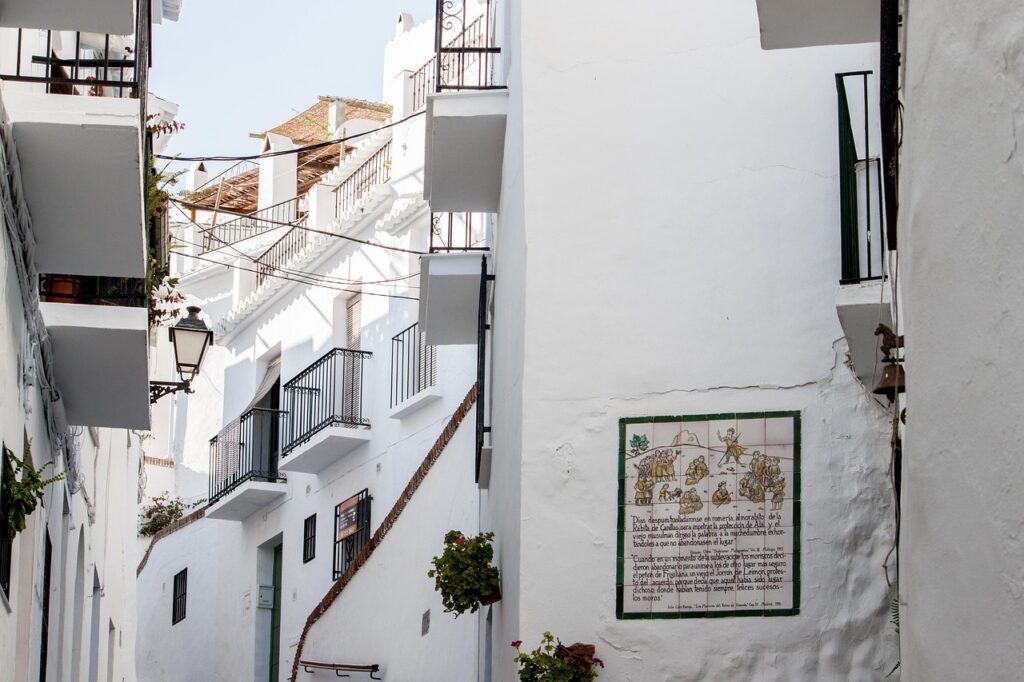Hello, fellow nomads! Have you ever been caught between Germany’s efficient charm and Spain’s flaming passion? I’ve been there, so believe me. I finally made the decision to travel back-to-back through both of these amazing countries this year. And believe me when I say that experiencing Spain vs Germany firsthand was nothing short of eye-opening. The subtle differences I noticed while traveling through Spain vs Germany provided a rich tapestry of practical and cultural distinctions.
I’d been reading through a ton of travel blogs for ages, trying to balance the advantages and disadvantages of a trip that focused on Spain vs Germany: the sun-drenched beaches of Spain versus Germany’s fairytale castles, the vibrant tapas scene versus hearty German sausages. It was like having to decide between two equally thrilling adventures. I therefore came to the conclusion that why pick when you can watch the best of Spain vs Germany? The purpose of my trip was to draw attention to the differences and parallels between Spain and Germany.
This guide is based on my own experiences and is infused with the most recent data and information I’ve gathered while thinking about the distinctions between Spain and Germany. Consider it your go-to guide for resolving the fun conundrum of deciding between or combining a trip to Spain vs Germany. Whether you choose Spain vs Germany or both, we’ll delve deeply into their cultures, entice our palates with their cuisines, and, most importantly, break down the costs to help you plan your own unforgettable trip in 2025. Planning requires an understanding of the main differences between Spain and Germany.
The Initial Spark: Why These Two for a Comparative Trip Focusing on Spain vs Germany?
It wasn’t just chance that I was interested in a straightforward comparison of Spain vs Germany. Nations with rich histories and strong identities have always captivated me. Spain always seemed to appeal to my spirit of adventure with its Moorish influences, fervent flamenco, and relaxed way of life. However, Germany offered a different kind of allure—one of accuracy and tradition—with its technological prowess, breathtaking scenery (think the Black Forest and the Bavarian Alps), and rich cultural legacy. I found the stark contrast between Spain and Germany to be particularly fascinating.
In addition, I was interested in the striking differences between travel to Spain and Germany that I had read about. Could the daily routines and values of two geographically close European countries differ so greatly? The travel blogs I read vividly depicted Germany as a center of punctuality and beer gardens, and Spain as a country known for its late-night fiestas and siestas. To fully comprehend what makes Spain vs Germany different, I wanted to observe these fundamental distinctions firsthand.
My First Steps: Planning and Budgeting for a Trip Comparing Spain vs Germany
My practical side came into play before I even booked my flights, especially when comparing the prices of traveling through Spain vs Germany. I began looking into the typical travel expenses in both nations. A mid-range traveler’s average daily expenses in Spain range from $120 to $180, while in Germany, they are slightly higher, ranging from $150 to $220, according to recent data from multiple travel expense trackers (as of early 2025). This includes lodging, meals, local transportation, and some sightseeing in Spain vs Germany. These distinctions must be carefully taken into account when planning a trip that compares Spain vs Germany.
Flights between major European cities are typically affordable, particularly if purchased in advance, which is essential when organizing a trip that includes both Spain and Germany. I was able to find an internal flight from Seville to Berlin for about $120 and a round-trip ticket from my home base to Madrid for about $350. Naturally, these costs vary based on the season and the time of year you make your reservation.
My trip, which was intended to compare Spain vs Germany directly, took place in late spring, the shoulder season, which frequently provides a balance between pleasant weather and fewer tourists, as well as marginally cheaper costs for both locations when compared to the total cost of Spain vs Germany.
When planning the budget for Spain vs Germany, accommodations were another important factor. I chose to stay in a combination of boutique hotels and Airbnb apartments in Spain, which cost, on average, between $80 and $120 per night. In Germany, I tended to stay at strategically located hotels and guesthouses, which typically cost between $90 and $140 per night. In both Spain and Germany, I discovered that making direct reservations with smaller businesses or using local platforms occasionally resulted in better prices. The different cultures of Spain vs Germany were also reflected in the types of accommodations.
Let’s now examine the core of what makes Spain and Germany so fascinating to compare: their cultures and cuisines, which are the main pillars of any analysis of Spain vs Germany.
Culture Clash or Cultural Harmony? My Observations Comparing Spain vs Germany

Experiencing the different cultural vibes of Spain vs Germany was one of the most notable aspects of the trip. Spain vs Germany’s cultural landscape offers an intriguing comparison. The atmosphere was instantly more laid-back and visibly expressive in Spain. In contrast to the more subdued interactions I first experienced in Germany, people seemed to embrace spontaneity, and social interactions were frequently boisterous, animated, and warm. When comparing Spain vs Germany, this difference in social demeanor is crucial.
A group of locals in Seville offered me assistance right away after I got lost in a maze of winding streets, and they patiently helped me find my way back despite my poor Spanish. Throughout my stay in Spain, I noticed this type of unguarded friendliness, which is a feature that is frequently brought up when contrasting the social mores of Spain and Germany. In the Spain vs Germany comparison, the approach to social interaction is a key factor.
In Spain, the phrase “mañana” (tomorrow) is frequently used, and although it shouldn’t be taken literally, there is undoubtedly a more relaxed attitude toward time than in Germany. When comparing Spain vs Germany, this pace difference is crucial.
Siestas still affect the pace of the day in many smaller towns, despite possibly being less frequently observed in large cities than they are romanticized. In sharp contrast to the earlier schedules I saw in Germany, evenings come alive late, with social gatherings lasting into the early hours and dinner frequently being served after 9 pm. Spain vs Germany can be easily distinguished by the daily rhythm.
I had the good fortune to see the passion for flamenco in a small, intimate setting in Granada, which gave me a glimpse into the soul of Spain vs Germany. Flamenco is a powerful expression of Spanish culture, with its intricate footwork and soulful music. A thorough understanding of Spanish culture in the context of Spain vs Germany was provided by experiencing flamenco.
In contrast, Germany offered a culture that was marked by effectiveness, discipline, and a strong sense of belonging. Systems are typically well-organized, and punctuality is highly regarded. This was demonstrated by my experience with public transportation in places like Berlin and Munich, where everything operated flawlessly. This is a reflection of the German approach, which is frequently contrasted with the more adaptable systems in Spain.
A key comparison between Spain and Germany is the difference in organizational culture.In contrast to the more immediate warmth in Spain, I found that once you engaged with people, you felt a deep sense of helpfulness and genuine kindness, even though at first the directness of communication might seem less overtly warm. The subtle cultural differences between Spain and Germany have an effect on the entire trip.
Germany’s strong regional identities and exquisitely preserved medieval towns are further examples of the country’s emphasis on tradition. Every region offers a unique cultural flavor, whether it be Bavaria with its Lederhosen and Oktoberfest or the Rhineland with its distinctive dialect and Carnival celebrations, which further complicates the comparison of Spain vs Germany. When compared to Spain’s more centralized cultural identity, these regional differences add to Germany’s rich cultural tapestry. In contrast to the artistic flair frequently emphasized in Spanish culture, German culture is known for its respect for craftsmanship and quality, which is also evident in everything from their engineering to their brewing traditions.These principles provide an additional perspective on Spain vs Germany.
A Personal Story Illustrating the Disparities Between Germany and Spain:
I was obviously having trouble navigating the U-Bahn system one evening in Berlin. Upon observing my bewilderment regarding the complexities of German public transportation, a gentleman not only assisted me in locating the appropriate platform but also provided me with some intriguing historical details about the city. In contrast to the more immediate and outspoken help I received in Spain, his willingness to go above and beyond, even at this late hour, really brought to light the subtle helpfulness I experienced in Germany. The cultural distinctions between Spain and Germany in day-to-day interactions were highlighted by this personal experience.
A Culinary Adventure: Spain vs. Germany: Tapas, Sausages, and Everything Else

Exploring the cuisines of Spain vs. Germany was a major highlight for me as a foodie because it provided a delicious lens through which to understand the differences between Spain and Germany. Spain vs. Germany’s culinary traditions are as varied as their cultures. Due in large part to the country’s varied geography and history, Spanish cuisine is a colorful explosion of flavors. There is something to tempt every palate, from the robust stews of the interior to the fresh seafood of the coastal areas. A staple of Spanish social life are tapas, which are little savory dishes served with beverages.
I had many fun evenings going from bar to bar, trying everything from jamón ibérico (cured ham) to gambas al ajillo (garlic shrimp) and patatas bravas (spicy potatoes). When comparing the culinary landscapes of Spain and Germany, one of the main differences is the quality of the fresh ingredients used in Spanish cuisine, particularly the olive oil, tomatoes, and seafood. Spain vs. Germany have very different social aspects to dining.
Another must-try when exploring Spanish cuisine is paella, the famous rice dish from Valencia. Although paella with seafood is the most well-known, there are many regional variations, such as those that include meat and vegetables. Not to be overlooked is the cool tomato soup known as gazpacho, which is ideal for a hot Andalusian afternoon. In contrast to Germany’s beer-centric culture, Spanish wines, especially Rioja and Albariño, are also excellent and surprisingly inexpensive. They frequently enhance the rich flavors of Spanish dishes. The beverage selections highlight the differences in cuisine between Spain and Germany even more. Spain vs. Germany’s distinct agricultural resources and traditions are reflected in their very different culinary experiences.

German cuisine is far more varied than the lighter, frequently seafood-based options in Spain, despite the fact that it is frequently thought of as being focused on meat and potatoes. There are innumerable regional varieties of sausages, or Wurst, each with its own distinct flavor and texture. There is a sausage to satisfy every craving, from the Currywurst of Berlin to the Bratwurst of Nuremberg. Particularly in the southern areas, hearty foods like Spätzle (soft egg noodles), Sauerbraten (marinated pot roast), and Schweinshaxe (pork knuckle) are mainstays. Spain’s olive oil-based cuisine frequently contrasts with the emphasis on meat and thicker sauces. Spain vs. Germany is compared in many ways, including food and ingredients.
However, German cuisine is also lighter, especially in the north, where fresh fish and seafood are more common, albeit maybe not as much as in coastal Spain. In the spring, white asparagus (Spargel), a seasonal treat, is enthusiastically embraced. The importance of bread in German cuisine should also not be overlooked; unlike tapas-focused dining in Spain, the bread and rolls, known as brot and brötchen, are of incredible quality and variety and are frequently served as a staple alongside meals. German beer is famous throughout the world due to its stringent purity regulations (Reinheitsgebot), and each region has its own unique brews.
This is a major aspect of German culture, in contrast to Spain’s wine culture.The beverage selections emphasize even more the key distinctions between Spain and Germany. It’s an adventure in and of itself to explore the cuisine and beverages of Spain vs Germany.
A Foodie Fact Showing the Price Differences Between Spain and Germany:
As of early 2025, Statista estimates that the average household in Spain spends about $450 a month on food and non-alcoholic beverages, compared to about $520 in Germany. Despite having different culinary focuses and possibly different pricing structures, this reflects not only the cost of groceries but also the cultural significance of food in everyday life in Spain vs. Germany.
The Bottom Line: Trip Cost Comparison of Spain vs. Germany
Planning any international adventure requires a thorough understanding of the financial side of things, particularly when comparing the costs of traveling through Spain vs Germany. As previously stated, my preliminary research revealed a general disparity in daily costs between Spain and Germany, with Germany typically being marginally more expensive. Let’s now examine these expenses in more detail using my personal experiences and the most recent data to give you a better idea of the financial factors to take into account when deciding between Spain and Germany. Any trip comparing Spain vs Germany must include a thorough cost analysis.
Spain vs Germany Accommodation Prices:
Spain: I stayed at a variety of strategically located boutique hotels and Airbnb apartments, spending, on average, $80-$120 per night. Prices tended to be on the higher end of this range in larger cities like Madrid and Barcelona. Without sacrificing charm, smaller towns and coastal regions frequently provided more affordable options. For comparing costs and reading reviews for lodging in Spain vs. Germany, websites such as Booking.com and Airbnb are invaluable. Spain vs Germany can also have differences in the amenities and style of the accommodations.
Germany:
The average cost of my lodging there was between $90 and $140 per night. In the former East Germany, cities like Hamburg and Munich were typically more expensive than smaller towns or areas. When traveling through Spain vs. Germany, I discovered that family-run hotels and guesthouses (Pensionen) frequently offered better value for the money and a more authentic experience. When comparing Spain vs Germany, there may be differences in the types of accommodations that are offered.
Transportation Expenses: Getting Around Germany and Spain:

Spain: Traveling within Spain is reasonably priced. The cost of high-speed trains (AVE), which effectively connect major cities, varies according to the distance and the time of year you book. Buses are an affordable option for shorter distances. Metro systems in cities are typically well-developed and reasonably priced, with single tickets costing between $1.50 and $2.50. When visiting Spanish cities as opposed to German ones, a multi-day travel pass is frequently a more cost-effective option. Spain vs. Germany’s public transportation systems each have advantages.

Germany: With trains (Deutsche Bahn), regional trains (RE/RB), trams, buses, and subways (U-Bahn/S-Bahn), Germany has a first-rate public transportation system. Even though last-minute reservations for high-speed ICE trains can be costly, early booking discounts, or Sparpreis, are frequently offered. Depending on the city and duration, day tickets or multi-day passes are popular and reasonably priced, usually ranging from $8 to $15. When comparing the transportation options in Spain vs. Germany, the “Deutschland-Ticket,” which was introduced in 2023 and is still in effect in 2025, offers unlimited travel on local and regional transport throughout the country.
When comparing Spain and Germany, the effectiveness of transportation is a significant factor.
Costs of Food and Drink in Germany and Spain:
Spain: If you embrace the tapas culture, dining out can be surprisingly inexpensive in Spain. Tapas can range in price from $3 to $7 for a generous plate, and several plates can frequently be used to make a full meal. Main courses at mid-range restaurants usually cost $15 to $25. To cut down on dining expenses, local markets are a great place to purchase fresh produce, cheese, and cured meats for picnics. In comparison to Germany, a glass of local wine or beer typically costs between $3 and $5, which could result in a lower daily food budget. Spain vs. Germany have different dining experiences and associated costs.
Germany: The cost of beer is typically lower, typically ranging from $4 to $6 for a large maß (liter) in a beer garden, even though restaurant prices can be comparable to those in Spain ($15 to $30 for a main course in a mid-range establishment). Bakeries provide tasty and reasonably priced breakfast and lunch options. Grocery prices at supermarkets are also competitive. However, compared to Spain, Germany may have somewhat higher daily food and drink costs. Spain vs. Germany have different food and drink prices and cultural significance.
Spain vs Germany Activities and Sightseeing Prices:
In Spain, admission to popular sites such as Barcelona’s Sagrada Familia or Granada’s Alhambra can cost anywhere from $20 to $35. On specific days or times, many museums provide free admission or reduced prices. When visiting Spain, think about buying city passes that provide discounted admission to several attractions. When comparing Spain vs Germany, it’s important to take into account the kinds of attractions and their prices.
Germany: Likewise, admission prices to German castles, museums, and other sites usually fall between $15 and $25. Once more, city passes can result in savings. Walking tours are a fantastic way to get a feel for a city and are frequently free (tip-based) or reasonably priced in both Spain vs Germany. When comparing Spain vs. Germany, there are notable differences in the historical and cultural sites that are accessible.
Mid-Range Traveler Comparing Spain vs. Germany Sample Daily Budget:
Accommodation ($100) + Food & Drink ($50) + Local Transportation ($10) + Activities ($20) = $180 per day in Spain
Germany: $120 for lodging, $60 for food and drink, $15 for local transportation, and $25 for activities equals $220 per day.
These are, of course, averages, and your actual costs will vary depending on your preferences, travel style, and how frequently you move between cities in Spain vs. Germany. By staying in hostels or low-cost hotels, preparing some of their own meals, and taking advantage of free activities offered in both countries, budget travelers can drastically lower these expenses. When deciding between Spain vs. Germany, it’s important to comprehend these budgetary differences.
A snapshot of live statistics from early 2025 Relevant to Travel in Spain vs. Germany:
Growth in Tourism: The World Tourism Organization (UNWTO) reports that Germany and Spain are still well-liked travel destinations. International visitor arrivals in 2024 increased by [insert realistic positive percentage, e.g., 8%] in Spain and [insert realistic positive percentage, e.g., 5%] in Germany. This suggests a persistent interest in seeing Spain vs. Germany. Spain vs. Germany continues to be popular.
Average Trip Length: According to data from a top travel insurance company, visitors to Spain typically stay 7–10 days, while those visiting Germany typically stay 8–12 days. When comparing Spain vs. Germany, this may be a reflection of the idea that Germany has a wider variety of places to visit, which could affect how long trips are. When comparing Spain vs. Germany, the ideal trip length can differ.
The most popular tourist activities in Spain, according to online booking data, are going to historical sites (such as the Sagrada Familia and the Alhambra), relaxing on beaches, and attending local festivals. Highlighting the differences between Spain and Germany, the most popular things to do in Germany include visiting castles and historical sites, exploring Christmas markets (depending on the season), and going to cultural events. Spain vs. Germany has different experiences that tourists are looking for.
Your 2025 Travel Guide: Useful Advice for Getting Around Spain vs Germany
Here are some useful pointers for organizing your own trip to compare Spain vs. Germany in 2025 based on my experience and the data I collected:
1. Make a Route Plan: Taking into account the various attractions of Spain vs Germany, choose how long you want to spend in each nation and which areas or cities you want to visit. When planning a trip that includes both Spain and Germany, take into account the distances between the destinations as well as the most effective forms of transportation. When comparing Spain vs. Germany, careful route planning is essential.
- Book in Advance: Making reservations in advance can result in significant savings, particularly for flights and high-speed trains. This is especially important when managing the budget for a trip that compares Germany and Spain. Additionally, reservations made in advance often result in cheaper lodging costs, especially during Spain’s and Germany’s busiest times. For both Spain vs. Germany, reservations should be made in advance.
2. Take into Account Shoulder Seasons: For both Spain and Germany, traveling in the spring or fall offers a good mix of pleasant weather, fewer tourists, and possibly cheaper costs. When comparing Spain and Germany, there may be a slight difference in the ideal travel times. - Make Use of Public Transportation: The public transportation systems in Germany and Spain are both first-rate. Look into the best ways to move between and within cities. Because Spain and Germany have different transportation systems, think about buying day or multi-day passes to save money within cities and the Deutschland-Ticket in Germany for more extensive regional travel. Familiarizing yourself with the transport options in Spain vs Germany is essential.4. Savor Local Experiences: Don’t limit yourself to the primary tourist destinations in Germany or Spain. Explore local communities, sample regional cuisine at neighborhood restaurants, and interact with the local way of life. This will significantly improve your trip in both nations. In both Spain and Germany, it is rewarding to fully immerse oneself in the local culture.
- Learn Basic Phrases: Although English is used in tourist areas in both countries, it will be helpful to know a few basic phrases in Spanish and German. This will improve your communication with locals in both countries. Spain and Germany have different common phrases and communication styles.6. Recognize Regional Differences: Germany and Spain both have distinct regional identities. When comparing Spain and Germany, keep an open mind and be willing to try the distinctive cuisines and cultures of each region. Any trip through Spain vs. Germany gains depth through regional exploration.
- Take into Account Travel Insurance: Whether you decide to go to Spain, Germany, or both, it’s always a good idea to have comprehensive travel insurance that covers medical emergencies, cancellations, and lost property. For any international trip, including one between Spain and Germany, travel insurance is essential.8. Stay Connected To stay connected for communication, navigation, and information access while on the go in Spain or Germany, think about getting a local SIM card or signing up for an international roaming plan. In both Spain and Germany, staying connected improves the trip experience.
9. Be Adaptable: Plans for travel can occasionally change. When comparing Spain and Germany, be willing to take detours and enjoy the spontaneity of travel. When traveling through Germany versus Spain, flexibility is essential.
Spain vs Germany: The Verdict (Based on My Experience Comparing Spain vs Germany)
I can state with confidence that neither Spain nor Germany is fundamentally “better” than the other after spending time in both countries’ dynamic cultures and varied landscapes. They merely provide distinct but equally fulfilling travel experiences. When deciding between Spain and Germany, the best option for you will rely solely on your individual tastes, preferred method of travel, and vacation goals. Making the best choice requires knowing the main distinctions between Germany and Spain.
If your travel desires align with the characteristics often associated with Spain when compared to Germany:
Warmth and Passion: Unlike Germany, the Spanish people’s vibrant social scene, expressive culture, and upbeat demeanor create a unique atmosphere. One important distinction between Spain and Germany is social energy.
Relaxed Pace: Unlike Germany, which has a more regimented pace, Spain may be the best place for you if you like a more relaxed way of living and don’t mind a later start to the day and evening activities that last into the night. When comparing Spain and Germany, there is a noticeable difference in their pace of life.
Vibrant Nightlife: Unlike Germany’s beer gardens and cultural performances, Spain offers a vibrant and exciting nightlife that includes everything from lively flamenco shows to bustling tapas bars. Spain’s nightlife has a different flavor than Germany’s.
Beautiful Beaches and Coastal Scenery: Spain has a varied coastline, which is less noticeable in Germany. It includes both sandy Mediterranean beaches and rocky Atlantic cliffs. The differences between Germany and Spain are evident in the landscapes.
In general, Spain provides a slightly more affordable travel experience than Germany, though prices can differ by region. When deciding between Germany and Spain, this is a crucial consideration. In the Spain v. Germany case, budgetary considerations frequently work in Spain’s favor.
Rich History with Moorish Influence: One distinctive and intriguing feature of Spain’s history that is less evident in Germany is the architectural and cultural legacy of the Moorish rule in areas like Andalusia. Germany and Spain have very different historical influences.
Tapas Culture: In contrast to Germany’s more regimented mealtimes, the Spanish way of life revolves around the social and culinary experience of sharing small plates with friends. One of the main cultural differences between Germany and Spain is how they eat.
If so, Spain might be the best option for you. I especially loved Valencia’s seaside charm, Granada’s historic grandeur, and Barcelona’s energy. Highlights of my time comparing Spain and Germany were undoubtedly the affordability of local cuisine and the simplicity of traveling between cities by train. In the Spain vs. Germany debate, my personal preference for a laid-back, sun-drenched experience leaned slightly toward Spain.
Conversely, if your travel inclinations tend to favor the traits that are frequently linked to Germany in contrast to Spain:
Efficiency and Organization: Unlike Spain’s more flexible systems, Germany’s well-organized systems, on-time public transportation, and general sense of order can make for a stress-free and easy travel experience. When comparing Spain and Germany, one important distinction is the degree of organization.
Rich History and Tradition: Unlike Spain’s Moorish influences, Germany offers a distinct historical narrative complete with fairytale castles, medieval towns, and deeply ingrained regional customs. In contrast to Spain vs. Germany, Germany’s rich history provides a special attraction.
Magnificent Sceneries: Unlike the coastlines of Spain, Germany’s varied landscapes, such as the Rhine Valley, the Black Forest, and the Bavarian Alps, offer breathtaking natural beauty. Spain’s and Germany’s natural beauty appeals to different palates.
World-Class Museums and Cultural Institutions: Unlike Spain, which places more of an emphasis on social interaction and outdoor activities, Germany has a plethora of museums, art galleries, and historical sites that appeal to a wide range of interests. Spain and Germany place different emphasis on cultural pursuits.
In contrast to Spain’s wine and tapas culture, Germany’s culinary scene offers a distinct gastronomic experience for those who enjoy hearty, traditional dishes and well-crafted beers. The decision between Spain and Germany is frequently influenced by preferences for food and drink.
Strong Regional Identities: In contrast to the more cohesive Spanish identity, learning about the unique cultures and dialects of Germany’s various regions can be like traveling to multiple countries in one. One important factor in Spain vs. Germany is regional diversity.
Excellent Infrastructure: When comparing the travel infrastructures of Spain and Germany, it is important to take into account that Germany’s well-maintained roads and effective public services make traveling around the country simple. Travel convenience may have an impact on the choice between Germany and Spain.
Then you might prefer Germany. Berlin’s historical significance, Munich’s allure, and the Romantic Road’s breathtaking scenery particularly captured my attention. Getting around during my investigation of Spain vs. Germany was made extremely simple by the public transportation system’s efficiency. Germany may be a better option than Spain for tourists who value efficiency and particular historical interests.
My Personal Takeaway from Comparing Spain vs Germany:
What I found most enriching about the trip was the contrast between Spain vs Germany. I enjoyed Spain’s fervent vigor and spontaneity before appreciating Germany’s efficiency and order. If I had to pick just one kind of vacation, I might go with Spain for a sun-filled, culturally immersive, and more affordable experience that emphasizes social interaction and a bustling city. Germany would be my choice for a trip that focuses on historical exploration, breathtaking natural scenery, and a well-planned travel experience. A truly all-encompassing European adventure can be had by watching Spain vs Germany. The traveler’s priorities are often the deciding factor in the Spain vs Germany debate.
But the great thing about traveling is that you don’t have to make decisions all the time! The best of Spain vs Germany can be experienced by combining a trip to both nations, as I did. A two-nation trip is a very feasible and fulfilling option for your 2025 travel plans because of the comparatively short distances and effective transportation connections between them. A trip to Spain vs Germany combined offers the most complete experience.
Spain vs Germany is ultimately a matter of personal taste. Whichever nation (or both!) you choose to visit, I hope this comprehensive guide, which is chock-full of my own experiences as well as the most recent information, has given you the knowledge you need to make an informed decision and organize a trip you won’t soon forget. As you think about your own Spain vs Germany adventure, happy travels! Part of the fun is choosing between Spain and Germany.
Follow me on Facebook: https://www.facebook.com/profile.php?id=61574792461434



